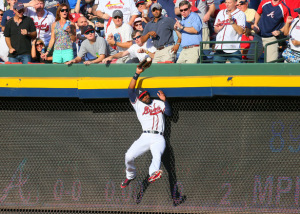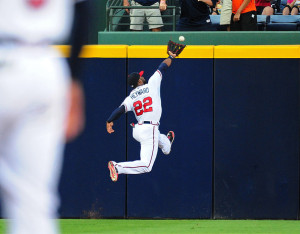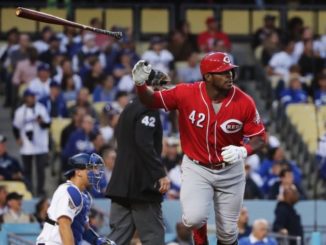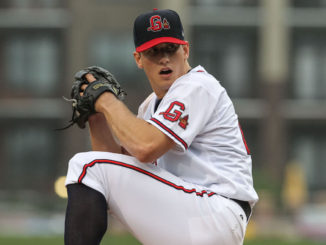
As you have probably heard, on Monday the Atlanta Braves traded RF Jason Heyward and RP Jordan Walden to the St. Louis Cardinals for SP Shelby Miller and SP prospect Tyrell Jenkins. The Jason Heyward trade was the first significant transaction of the 2014 off-season, and signaled the first major move in the Braves’ ‘minor rebuild’ effort.
First, let me say this: I love watching Jason Heyward play baseball. How can any true fan of the game not? He runs the bases aggressively, but not recklessly, making him one of the better baserunners in the game, despite modest stolen base totals. He plays elite outfield defense at levels not seen since Andruw Jones, even with a relatively average arm. His reaction times and instincts when the ball leaves the bat are unreal. The routes he takes to the ball are among the most efficient in baseball. Even as a batter, Jason Heyward has been above average, posting a career wRC+ of 117 (or, 17% above the average player in terms of total Runs Created, adjusted for park and league). He’s below the league average in strikeouts, and above the league average in walks. This, in spite of being labeled by a very large and vocal contingent of fans as a ‘bust’ and as Jeff Francouer v2.0. He plays the game like he is having fun, and it shows. Jason Heyward’s value lies in the fact that, besides defense, he doesn’t do any thing at a ‘best in game’ level, but he does everything at a ‘better than most in the game’ level. Few players in baseball are as well-rounded and as valuable overall as Heyward.
Now, on to the trade.
[sc:InContentResponsive ]
Setting Up the Trade
The Braves realized that they need to retool their team if they wanted to return to the levels of competing for a World Series. The lineup had several holes that needed to be addressed. By ‘several’, of course, I mean everyone not named Freddie Freeman or Justin Upton. Even Heyward, as much as I like him, saw a significant drop in power in 2014. The starting rotation, while one of the best in baseball in 2014 and the primary reason the Braves weren’t a 70 win team, lost Ervin Santana and Aaron Harang to free agency following the season (Santana was extended a Qualifying Offer by the Braves, and declined it). Four hundred innings of starting pitching disappeared overnight. While starting pitching was a strength of the Braves during the season, it suddenly became a major concern after the season ended.
In addition to having to address simple roster needs, there were two very large contractual issues looming. Both Jason Heyward and Justin Upton were entering the final years of their contracts, able to become free agents following the 2015 season. The Braves possibly had the payroll flexibility to extend one of the two, but almost certainly were incapable of extending both. As a result, at least one of them was going to be lost following the 2015 season. And there was no help coming up from a depleted minor league system. The majority of Atlanta’s position player prospects were promoted to the big league club between 2010 and 2012. After the trade of former General Manager Frank Wren’s son Kyle Wren (in a rather puzzling move), the Braves have no prospects knocking at the door of the big league club. Even prized prospects Jose Peraza and Kyle Kubitza are thought to be a year away.
This presented a dilemma for John Hart and company: Should the Braves play the ’15 season with Heyward/Upton, taking advantage of their services while also attempting to extend them? Or, should they attempt to trade one (or both) before the season started? Or, in a third option available, should they play the first half of the season trying to compete, and then trade one (or both) at the 2015 trade deadline?
The Options
Play The 2015 Season With Heyward
This option was a viable option in most circumstances. It allows the Braves to receive the player’s contributions, while also giving them the opportunity to attempt an extension during the season. In addition, in the week following the end of the ’15 season, the Braves would have exclusive negotiating rights with the player(s), giving them another opportunity to work out a new deal. If no agreement could be reached, the team then has the option of extending a Qualifying Offer to the player(s). If the player declines the offer and signs elsewhere, the Braves would receive a compensatory pick in next year’s draft (after the first round ends, but before the second round begins).
However, as noted above, this wasn’t a normal circumstance for the Braves. For the first time in a quarter-century, the Braves were looking at a ‘rebuilding’ scenario, according to some pundits. With a new stadium slated to open in 2017, the Braves can’t afford to go into a full rebuilding mode like some teams have. The Braves need a team that will be competitive in 2017. As such, accepting a compensatory pick for Jason Heyward (or Justin Upton) just wouldn’t fit those plans. A player drafted in 2016 isn’t going to be ready to play in the big leagues in 2017. And the extra season of Heyward (and Upton) in 2015 wouldn’t go towards replenishing the minor league pipeline. Sure, the compensatory pick would go into that pipeline, but that is merely one prospect, who may or may not even pan out.
[sc:InContentResponsive ]
Trade Heyward At The 2015 Trade Deadline

Another choice the Braves had was to play the first half of the 2015 season with Jason Heyward to see how competitive they could be (and to continue trying to work out an extension), and then move him at the July trade deadline. This would give Heyward a chance to help the Braves, while also potentially showcasing himself for trade partners.
However, this is actually the least valuable option from the Braves’ standpoint. At least in theory, trading Heyward before the season starts means that potentially 29 teams are interested. But trading him at the deadline reduces that pool of interested teams to primarily the 14 or so teams competing for a playoff spot. The potential list of partners is immediately cut in half. In addition, if the Braves trade Heyward at any time during the season, they lose the ability to make a qualifying offer, and thus subsequently lose any compensatory pick they could have received. While I believe Heyward is worth far more than just a compensatory pick, this route ensures that Atlanta would receive the least return of the options they have available., since the team receiving him would only have him for 2 months, and would not have the chance to offer him a QO or to negotiate exclusively (post-season) with him.
[sc:InContentResponsive ]
Trade Heyward Before The 2015 Season
Trading him before the season started was the most likely way to maximize the return for Jason Heyward. The team receiving him would receive a full season of production. They would also receive the right to exclusively negotiate with him and/or the right to offer a QO at season’s end. The receiving team would at least be able to receive a compensatory pick (if he signed elsewhere) to help them recover from the acquisition cost.
The downside to this, of course, is that the Braves would lose one of their most valuable players for 2015. For a team featuring a good number of flyball pitchers, losing an elite level outfielder is a big blow. Add to that the discussions of playing a…ummm…less than stellar left fielder in Evan Gattis (as has been rumored), and suddenly the Braves are appearing to move well away from the ‘Defense’ portion of their long-term philosophy of Pitching + Defense = Wins.
The Players
The Braves receive:
RHP Shelby Miller
Miller is amazingly unknown by a large number of Braves fans, if the Twittersphere is any indication, which is weird considering he has made 5 post-season appearances for a team that many Braves fans point to as a team to emulate. Weird how so many fans can see what St. Louis does to ‘build a World Series team’ while missing the players on that very team. But, I digress.
Miller is young, cheap, and controllable at a position the Braves direly need to fill. Entering Monday, the Braves had three starting pitchers penciled in for 2015: Julio Teheran, Alex Wood, and Mike Minor. Miller will immediately add depth and innings at a spot that appeared weak entering next season.
Shelby has a career ERA of 3.33, but owns a higher career FIP of 4.03. He appeared to struggle in 2014, but that was really a study in two different seasons. In the first half of 2014, Miller posted a 4.29 ERA (4.78 FIP) in 109 innings, with a WHIP of 1.468. But in the second half, he put up a 2.92 ERA (4.18 FIP) in 74 innings, with a WHIP of 0.986. Miller significantly cut down on his walks and increased his command of his primary pitch–something that Eno Sarris at Fangraphs delved into a few days ago.
Given Roger McDowell‘s success with pitchers over the years, it is very possible that Miller can develop into a solid top of the rotation option. More likely he will be a good middle rotation pitcher for several years, and that is something that has value. Realistically, we can expect Miller to be somewhere between an average Aaron Harang and a good Ervin Santana, putting up between 2.2 and 4.5 WAR. But in order to provide that value, Miller needs to be the pitcher that he has been for 261 of his career 370 innings.
RHP Tyrell Jenkins
Miller was the big name in the Jason Heyward trade, but Jenkins may have been the steal. Jenkins was a Top 100 Prospect for Baseball Prospectus, having been taken 50th overall in the 2010 draft. He’s big (6’4″) and athletic (turned down a football scholarship from Baylor), and he has a very good 2 first pitches: a fastball in the mid-90s with movement, and a big, sweeping slider. He’s projected to be a middle rotation guy if he can overcome a couple of minor league setbacks, but I wouldn’t be surprised to see him groomed as a closer or set-up man capable of closing.
Those minor league setbacks I mentioned? Shoulder injuries. I generally am very wary of shoulder injuries in pitchers; the technology to make a new shoulder just does not exist yet, like it does with elbow ligaments. That’s one reason I foresee a move to the bullpen in the future. But despite the shoulder injury history, Jenkins has been recently effective, throwing 24 1/3 innings in six starts for the Peoria Javelinas in the Arizona Fall League. He posted a 2.22 ERA (3.48 FIP, 1.367 WHIP) while facing players further along in their professional careers than he is. (Note: The Braves’ Aaron Northcraft was a teammate of Jenkins, and posted a 2.22 ERA (4.31 FIP, 1.16 WHIP) in 22 1/3 innings covering six starts.)
Tyrell Jenkins is still a prospect, and still somewhat of a project. If he can improve his control a little (something that tends to return with more work after injury) and if he can improve his changeup and curve even a little, he could be a middle rotation starter. But his electric slider and plus fastball are already good enough (provided his control improves) to consider him an option in short, late-inning relief. the jury is out on how he will turn but, but he has tremendous upside.
The Cardinals receive:
RF Jason Heyward
Since his arrival in 2010, Jason Heyward has been one of the most valuable players in baseball, ranking 18th in fWAR out of 338 qualified batters over that period. While one can rightly argue that WAR overvalues Heyward for his defensive prowess, he still has posted a wRC+ of 117, making him well above average offensively alone. He ranks 39th out of those 338 qualified batters in Offensive Runs Above Average, which is still in the top 12% of regular players in baseball.
The idea that he has been a ‘bust’ offensively is precipitated by the fact that most fans A) have unrealistic expectations, B) don’t know enough about any teams beyond their own to know how players actually compare to one another, and C) bought into hype and hyperbole from bloggers and writers. Heyward has never really been a big home run hitter, instead showing mostly gap doubles ability throughout his career, including the minors. Sure, he has hit 27 home runs once in the majors. but that seems to be an outlier to me, and was helped by him being left alone at one spot in the lineup (3rd) most of the year, and having the benefit of a Hall of Famer or a Silver Slugger hitting behind him for that time. In fact, one could point to that season and the second half of 2013 (after he was moved to leadoff) and say that Heyward prospers when pitcher can’t really pitch around him. In those two seasons, he had Chipper Jones, Brian McCann, or Justin Upton hitting behind him, and he was nearly unstoppable.
The Cardinals have signaled with this move that they are ‘all-in’ on the 2015 season, similar to the Braves when they traded for J.D. Drew. Heyward will provide them with the quality middle of the order bat and outstanding defense that became necessary after the tragic death of top prospect Oscar Tavares. St. Louis is getting a terrific ballplayer with a terrific potential to get better. But, Heyward has also been losing power as pitchers have changed their approach to him. They now pound the strike zone up against him, and he has shown to be very vulnerable there. Also, Heyward has significant platoon splits: .839 OPS vs RHP, and .651 OPS vs LHP. But even his failures against LHP have yielded a career wRC+ of 81, which, while pretty bad, is comparable to that of Carl Crawford and Michael Saunders, players who have been mentioned as potential replacements for Heyward by the ‘video game GM’ contingent of Atlanta fans. Another replacement mentioned, Andre Ethier, has a 67 wRC+ vs LHP as a LHB. Jackie Bradley, Jr. and Nyjer Morgan, even more mentioned replacements, are even lower. Bottom line: Heyward is bad against LHP, but not bad enough, given his other abilities, to justify a platoon.
While keeping Jason Heyward would have made a lot of Braves’ fans happy, the reality is that he was unlikely to re-sign with Atlanta. Whether that is because the Atlanta front office never approached him (which counters reports of a long-term deal that was offered last season that didn’t meet his satisfaction) or because Heyward has always wanted to test free agency is up for debate. While I have no specific information to support it, I do believe that someone in the front office may have ‘poisoned the well’, so to speak, in regards to Heyward. In any event, once it became apparent that Heyward would not be extending with Atlanta (regardless of why), moving him became the only logical option.
RHP Jordan Walden

The Cardinals also received set-up man Jordan Walden in the trade. Walden is a solid late inning reliever with closer experience, having saved 32 games for the 2011 Angels. Walden has a 95+ fastball and a wicked slider that have led him to a career 10.8 K/9 rate. His career ERA of 3.10 is decent, while he has outperformed that to the tune of a 2.80 FIP. Walden is a very reliable bullpen piece who can provide the Cards with needed depth, and also serve as a closer option should newly minted closer Trevor Rosenthal struggle. Also, Jordan Walden hops when he pitches.
Walden became expendable as he entered his arbitration years. The Braves feeling was that they could better use the roughly $2.5M they would save by moving him rather than paying an arbitration raise. Newly acquired pitcher Arodys Vizcaino could eventually slip into the role formerly occupied by Walden.
[sc:InContentResponsive ]
The Result
The Braves made a sound business decision in moving Heyward and Walden. By doing so, they cleared about $10.5M in additional salary. They did lose three years of player control (1 year of Heyward, and 2 years of Walden), but that was offset by the addition of four years of team control of Miller, and potentially six more for Jenkins. In terms of production, the Braves likely traded about 5.5 Wins in 2015 for 3 Wins in 2015, if we just consider the MLB players in the deal. If we add in the Wins expected from a roughly league average RF, we could expect the deal to be a wash for 2015. Given the amount of money cleared by the transaction, it is possible, depending on other moves, that the Braves can completely offset the loss of Heyward and Walden. At that point, this deal becomes a win for Atlanta, as long as Miller produces at slightly above league average rates.
As a fan of baseball, the Braves, and Jason Heyward, this deal was kick in the nuts. But, while I think they could have obtained Miller and Jenkins straight up for Heyward, the deal makes sense at the time it was made. Whether it will turn out to be a good move is yet to be determined.




I agree, tho the good thing about Jenkins’s shoulder injury is that it was a separated Lat muscle and nothing to do with the rotator cuff or labrum. So it’s a LOT less of a long term fear.
True. I think Jenkins has good upside. Perhaps they could have gotten a little more for Heyward and Walden than Miller and Jenkins, but that’s a little nit-picking, I think. We obtained a good young pitcher with control, and a high upside pitcher with full control. Sucks seeing Heyward go, as he is one person I just love watching play the game. But I understand the move.
Nice Prospect post… Unrelated question for you… As a lifelong O’s fan, I was wondering what your opinion of the Markakis signing was?
(No need to post this if you wanted to respond in private)
Thanks
Thanks for reading!
I started to reply, and then it got a little lengthy, so I just turned it into a new post. you can see it at https://outfieldflyrule.com/2014/12/15/nick-markakis-signing/.
My basic takeaway is that he seems to be a very good complementary piece to something or someone. What that is, I haven’t seen yet.